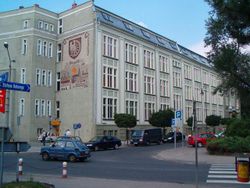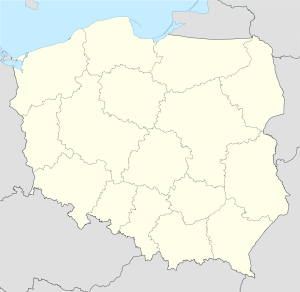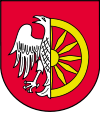Racibórz
- For the community in Saxony, Germany, see Radibor. For the village in northern Poland, see Racibórz, Warmian-Masurian Voivodeship.
| Racibórz | |||
|---|---|---|---|
 |
|||
|
|||
 Racibórz
|
|||
| Coordinates: | |||
| Country | |||
| Voivodeship | Silesian | ||
| County | Racibórz County | ||
| Gmina | Racibórz (urban gmina) | ||
| Established | 12th century | ||
| City rights | 1217 | ||
| Government | |||
| - Mayor | Mirosław Lenk | ||
| Area | |||
| - City | 74.96 km2 (28.9 sq mi) | ||
| Population (2006) | |||
| - City | 57,352 | ||
| - Density | 765.1/km2 (1,981.6/sq mi) | ||
| - Metro | 115 164 | ||
| Time zone | CET (UTC+1) | ||
| - Summer (DST) | CEST (UTC+2) | ||
| Postal code | 47-400 to 47-445 | ||
| Area code(s) | +48 32 | ||
| Car plates | SRC | ||
| Website | http://www.raciborz.pl | ||
|
|||||||||||||||||||
Racibórz [raˈt͡ɕibuʂ] (German: Ratibor, Czech: Ratiboř) is a town in southern Poland with 60,218 inhabitants (2006) situated in the Silesian Voivodeship (since 1999), previously in Katowice Voivodeship (1975–1998). It is the capital of Racibórz County.
The name Racibórz is of Slavic origin and comes from the name of Duke Racibor, the city's founder.
Contents |
History
Until the end of the 5th century AD, the lands of the later Racibórz settlement were inhabited by East Germanic Silinger tribes.
Racibórz was one of five strongholds of the Slavic Golezyce (Golenshitse, Holasici in Czech), a proto-Polish tribe. Racibórz, as a stronghold, was mentioned in a work of the "Bavarian Geographer" in 845. It was the first historical capital of Upper Silesia. The Duchy of Racibórz was established by Duke Mieszko Plątonogi in 1172. The city was granted municipal privileges in 1217. From 1299 Racibórz was ruled by its own city council. The last duke of the Piast dynasty died in 1336 and from that time until 1521 the duchy and the city were ruled by the cadet branch of the Přemyslid dynasty. Racibórz was also ruled by the duke of Opole. The first coin with the Polish description "MILOST" was issued in Racibórz, in 1211 as well the first Polish national anthem "Gaude mater Polonia" which was written ca. 1260–70 in Latin by a brother from the Dominican monastery in Racibórz.
After the medieval Eastward settlement of German settlers, farmers and traders, which was stimulated by the Polish and Czech rulers, princes and officials of Upper Silesia, from the 13th century onward Racibórz became known as Ratibor and was heavily Germanized linguistically and culturally. In 1521 Ratibor came under rule of the Opole (Oppeln) dukes, vassals of Bohemian kings; later succeeded by Hohenzollerns and Habsburgs. In 1742/48 it was ceded to Prussia (with most of the Silesian territory). Prussian policy increased the Germanification.
The famous German poet Joseph Freiherr von Eichendorff, a Roman Catholic Silesian nobleman, was born at Schloss Lubowitz in Ratibor in the 18th century. Until 1945 Ratibor remained German, and the majority of its inhabitants were Germans or Germanized Upper Silesians.
After end of World War II, in June 1945, army of Czechoslovakia briefly entered into the then-German Ratibor and Czechoslovakia officially claimed the area of Racibórz and Głubczyce (Ratibořsko and Hlubčicko) because of having a substantial Czech minority. See border conflicts between Poland and Czechoslovakia for details. At the same time the expulsion of Germans by both Czech and Polish militias started and the region was virtually ethnically cleansed from Germans, as the town, came to lie far into the territory of the post-war Republic of Poland as defined at the Potsdam Conference. The German CDU politician Herbert Hupka at the end of his life promoted reconciliation between the former German inhabitants, including himself, and the new Polish settlers and administration of Racibórz (Ratibor).
International relations
Twin towns — Sister cities
Racibórz is twinned with:
|
External links
- Official website (Polish)
- Partnership with German city Leverkusen (German)
- Photographs of Racibórz and environs
- Customs House in Ratibor
|
||||||||||||||

